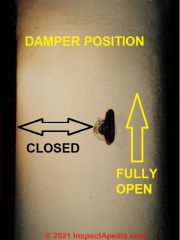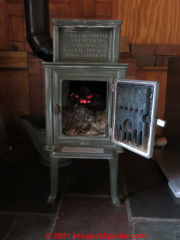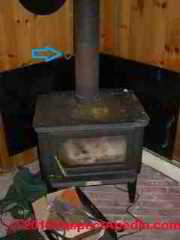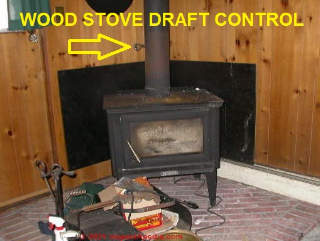 Wood Stove Draft Adjustment & Control How to adjust the draft to control woodstove heat & fire
Wood Stove Draft Adjustment & Control How to adjust the draft to control woodstove heat & fire
- POST a QUESTION or COMMENT about how to set and control the draft on a wood-burning stove
Types
This article series defines and describes barometric dampers, draft regulators, automatic flue dampers, draft inducers, zone dampers, HVAC supply register controls, fire dampers, automatic fire and smoke dampers, fireplace dampers, and fresh air inlet dampers and controls. controls.
InspectAPedia tolerates no conflicts of interest. We have no relationship with advertisers, products, or services discussed at this website.
- Daniel Friedman, Publisher/Editor/Author - See WHO ARE WE?
List of the Air, Draft, Damper Controls on Wood Stoves
Following this catalog of all of the controls you might expect to find on most wood stoves, we give details of how to test your woodstove for proper draft and then we describe how to adjust the draft and combustion air to control the woodstove's fire size, heat, output.
Watch out: in reading your wood-stove's draft adjustment instructions be sure to keep clear which control is being discussed.
- Wood stove primary combustion air control:
varying in design for each stove, this control adjusts the volume or rate of primary combustion air entering the stove's fire box.
More air = hotter fire.
On our Jotul woodstove above, found in our friend PG's home, the orange circle surrounds the combustion air inlet. (Notice that PG's wood is stored too close to the stove for good fire safety.)
- Woodstove catalytic combustor damper controls: automatic + manual
- found on most woodstoves that use a catalytic combustor, an automatic control regulates air flow inside the stove itself in order to control the combustor, and on at least some woodstoves a second, manual control activates, or de-activates the catalytic combustor by controlling air through it.
- Chimney draft control - damper:
We illustrate the typical location of a wood stove chimney draft control above.
The direction of the draft control handle shows the open or closed or partly-closed position of the actual damper door inside the flue.
Above: using a common manual damper photo as an example, the position of the black handle, where handle across vent indicates whether the chimney, vent, or duct is closed while set parallel to the vent (as it is in the photo) the vent is fully open.
- Woodstove firebox door:
any wood-burning heater will have a door that is opened to build the initial fire and to add more wood to it. (Photo above)
Some wood stoves are designed to permit operation with that door open wide or even removed, replaced by a fire-screen. In this mode the stove is functioning like an open fireplace. In fireplace mode the stove may look pretty but in most designs this is not going to produce a net heat gain to your building.
So much air flows from the room through the open fireplace and up the chimney that it draws more cool outdoor air into the building for a net heat loss, even if those sitting close to the fireplace feel toasty warm.
Watch out: while some folks might leave a woodstove door slightly-ajar after initially lighting its fire in order to "get the fire going quickly", never operate a woodstove in "door ajar" mode for more than a few minutes and never leave the stove un-attended, not even for a minute, in this mode.
The "door ajar" or "door open a crack" mode gives so much combustion air blowing so fast onto the fire that the woodstove can overheat, be damaged, and can even cause a house fire. Don't do that.
DRAFT MEASUREMENT, CHIMNEYS & FLUES describes how to measure chimney or exhaust draft using instruments.
Wood Stove Draft Adjustment & Control
Woodstove chimney draft control - damper
Found on most woodstoves is a simple mechanical damper on the woodstove exhaust pipe between the stove and the chimney.
I'm not so sure the wood burning stove shown above is a fire-safe installation, but you can plainly see the manual flue damper handle (pointed-to by our blue arrow) in the rusty flue section about 30 inches above the top of the woodstove.
Shown in a closer look at a woodstove chimney draft control in our second photo above, using a common manual damper photo as an example, the position of the black handle, where handle across vent indicates whether the chimney, vent, or duct is closed while set parallel to the vent (as it is in the photo) the vent is fully open.
This control control regulates the strength of the stove's exhaust draft (closed = least draft, coolest-operation).
We illustrate the typical location of a wood stove chimney draft control above.
The direction of the draft control handle shows the open or closed or partly-closed position of the actual damper door inside the flue.
Wood Stove Draft Test Procedure
 Checking the wood stove draft helps manage the fire's strength, heat, and assures proper exhaust venting.
Checking the wood stove draft helps manage the fire's strength, heat, and assures proper exhaust venting.
Wood stove damper control: adjusts the rate of exhaust of combustion gases and smoke from the woodstove up into the chimney. More exhaust = hotter fire and less heat transfer into the room; Less exhaust = slower, smaller fire.
Shown here: our yellow arrow points to the draft outlet control on this wood burner.
A simple empirical test of woodstove draft adequacy is to watch the fire when you close-down or open-up the air inlet control to your woodstove.
To make these simple observations you need to have let the wood stove operate with a normal sized fire for 10-15 minutes or longer to be sure that the chimney used to vent the stove is fully warmed and thus is providing its normal draft.
Good Woodstove Draft
Fire is brisk and the only combustion air inlet is through the normal stove's combustion air inlet: this shows that there is a good draft.
Indicators of Wood-Stove Draft Trouble
Fire doesn't change: If even after watching for a minute or two you see no change in the wood stove fire's height or level of activity when you change the air inlet settings, then look for the following woodstove draft trouble causes:
- the stove's draft is weak - is the draft control open? -
see WOODSTOVE DRAFT CONTROL - the stove is installed in a location where there is inadequate combustion air supply -
see COMBUSTION AIR for WOODSTOVES - the stove's chimney damper control is closed or the chimney is blocked -
see BLOCKED CHIMNEY FLUES - the catalytic combustion woodstove is puffing smoke -
see WOOD STOVES, CATALYTIC PUFF-BACKS - the chimney's draft is weak because of other chimney defects like air leaks into the flue, an open chimney cleanout door, or a chimney that is too short -
see CHIMNEY HEIGHT & CLEARANCE CODE
When the wood stove chimney draft is weak you need to allow the fire to increase in heat and strength a bit before you can close down the damper.
Review your woodstove's draft settings to be sure they are correct.
Woodstove Combustion Air Inlet Control of Fire Strength & Heat Output
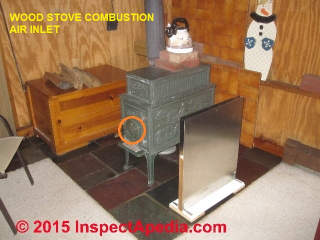 Indirectly the woodstove's outlet draft will be affected by the fire strength and the rate of supply of incoming combustion air.
Indirectly the woodstove's outlet draft will be affected by the fire strength and the rate of supply of incoming combustion air.
When the damper handle's long axis is parallel to the flue the damper is in its fully open position.
Woodstoves also regulate the wood fire and thus stove temperature by adjusting the combustion air intake to the woodstove.
Below is a beautiful Jotul woodstove that I (DF) traded to Paul Galow for a fancy wristwatch. The orange circle surrounds the woodstove air inlet draft control.
Watch out: if the incoming combustion air cannot be shut down because of leaky wood stove gaskets or other damage the wood stove is unsafe.
Paul has installed air-spaced heat shields of ceramic tile mounted on fireproof board behind the stove and he added a heat shield (the silver contraption) on the side of the stove facing a bed just to slow down the heat in that direction.
That wood-box on the left side of the stove is a bit close in my OPINION but Mr. Galow is not much impressed by my caution.
Watch out: if the flue damper rusts or becomes damage it may be impossible to slow the chimney draft, resulting in an over-heating stove and possibly a chimney or house fire. Though questionable fire clearances and accumulated creosote may have been factors, just such a runaway wood stove fire and its disastrous results are illustrated
at CHIMNEY FIRES & WOOD STOVE SAFETY
...
Continue reading at WOOD STOVE DRAFT TEST how to determine if your woodstove has the right draft and combustion air settings, or select a topic from the closely-related articles below, or see the complete ARTICLE INDEX.
Or see these
Recommended Articles
- COMBUSTION AIR for WOODSTOVES
- CREOSOTE FIRE HAZARDS
- DAMPERS & DRAFT REGULATOR TYPES
- DRAFT INDUCER FANS
- DRAFT MEASUREMENT, CHIMNEYS & FLUES
- DRAFT REGULATOR, DAMPER, BOOSTER
- FIRE CLEARANCES INDOORS
- FIRE CLEARANCES, WOOD COAL & PELLET STOVES
- HEAT SHIELD SPECIFICATIONS for WOOD STOVES & PELLET STOVES
- PYROLYSIS EXPLAINED
- SHARED CHIMNEY & FLUE HAZARDS - home
- WOOD-OIL COMBINATION HEATERS
- WOOD STOVE, CATALYTIC PUFF-BACKS
- WOODSTOVE DRAFT CONTROL
- WOOD STOVE DRAFT TEST
- WOOD STOVE OPERATION & SAFETY
Suggested citation for this web page
WOODSTOVE DRAFT CONTROL at InspectApedia.com - online encyclopedia of building & environmental inspection, testing, diagnosis, repair, & problem prevention advice.
Or see this
INDEX to RELATED ARTICLES: ARTICLE INDEX to BUILDING FIRE SAFETY
Or use the SEARCH BOX found below to Ask a Question or Search InspectApedia
Ask a Question or Search InspectApedia
Try the search box just below, or if you prefer, post a question or comment in the Comments box below and we will respond promptly.
Search the InspectApedia website
Note: appearance of your Comment below may be delayed: if your comment contains an image, photograph, web link, or text that looks to the software as if it might be a web link, your posting will appear after it has been approved by a moderator. Apologies for the delay.
Only one image can be added per comment but you can post as many comments, and therefore images, as you like.
You will not receive a notification when a response to your question has been posted.
Please bookmark this page to make it easy for you to check back for our response.
IF above you see "Comment Form is loading comments..." then COMMENT BOX - countable.ca / bawkbox.com IS NOT WORKING.
In any case you are welcome to send an email directly to us at InspectApedia.com at editor@inspectApedia.com
We'll reply to you directly. Please help us help you by noting, in your email, the URL of the InspectApedia page where you wanted to comment.
Citations & References
In addition to any citations in the article above, a full list is available on request.
- Airflow Breeze air movement register booster fans are produced by AirFlow Technology, Airflow Technology 1427 West 86th Street, Suite 328 Indianapolis, IN 6260 1-800-458-5540 website: http://www.aftproducts.com/Airflow_Breeze_3ff0ef340c6e0e13b.dept
- In addition to citations & references found in this article, see the research citations given at the end of the related articles found at our suggested
CONTINUE READING or RECOMMENDED ARTICLES.
- Carson, Dunlop & Associates Ltd., 120 Carlton Street Suite 407, Toronto ON M5A 4K2. Tel: (416) 964-9415 1-800-268-7070 Email: info@carsondunlop.com. Alan Carson is a past president of ASHI, the American Society of Home Inspectors.
Thanks to Alan Carson and Bob Dunlop, for permission for InspectAPedia to use text excerpts from The HOME REFERENCE BOOK - the Encyclopedia of Homes and to use illustrations from The ILLUSTRATED HOME .
Carson Dunlop Associates provides extensive home inspection education and report writing material. In gratitude we provide links to tsome Carson Dunlop Associates products and services.


